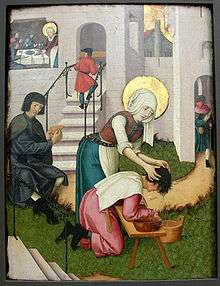Verena
| Saint Verena | |
|---|---|
 | |
| Born |
3rd century Garagos, Egypt |
| Died |
344[1] Bad Zurzach, Switzerland |
| Venerated in |
Coptic Orthodox Church Eastern Orthodox Churches (1 September) Oriental Orthodox Churches Roman Catholic Church (1 September) |
| Feast |
|
| Attributes | comb; water jar |
| Patronage | poor; sick; lepers; young girls, nurses, Pieter |
Verena, (Coptic: Ϯⲁⲅⲓⲁ Ⲃⲓⲣⲏⲛⲁ) is venerated as a saint by the Coptic Orthodox Church, by the Roman Catholic Church, and by the Eastern Orthodox Church. According to tradition, she was associated with the Theban Legion and died on the 4th day of Thout (September 14).
Tradition states that she was brought up in the 3rd century in the Theban region (modern day Luxor in Upper Egypt) in a noble Christian family.
Travel to Switzerland
The name Verena means "the good fruit".[1] According to tradition, Verena was of a noble Christian family from the village of Garagous, near Luxor. He parents sent her to Sherimon, Bishop of Beni Suef, to be instructed in the Christian faith, after which he baptized her. She was a relative of Saint Victor (or alternately, Saint Maurice)[2] of the Theban Legion. As soldiers' relatives were allowed to accompany them in order to look after them and take care of their wounds, Verena accompanied the legion on its mission to Rhaetia (part of modern-day Switzerland). (Other accounts say Verena traveled to Switzerland in search of her relative.)[3]
Verena was still in Milan when word was received that Saint Maurice, Saint Victor and the other members of the Theban Legion, who had proceeded north, were martyred. Verena went to Agaunum to venerate them. First, she led the life of a hermit in a place called Solothurn, from there she went to Koblenz, but later moved into a cave near present-day Zurich.[4] As a hermit, Verena fasted and prayed continuously. Several miracles were attributed to her intercession. Verena was a spiritual counselor for young girls and due to her expertise as a nurse used to look after their physical health.[2]

As a result of her fame, legend states that the local governor arrested her and sent her to jail, where Saint Maurice appeared to her to console and strengthen her. After she was released from jail, she continued her good works.
Due to her, many converted to Christianity. Saint Verena fed the poor and nursed the sick, especially those suffering from leprosy. She used to wash their wounds and put ointments on them, not fearing infection. She died in Switzerland in 344.
Veneration
The Verena Minster church was built over the grave of Saint Verena in a Roman cemetery.[5] She is one of the most revered saints in Switzerland.[4]
Return of part of relics to Egypt
In 1986, a delegation from Saint Verena's Church in Switzerland, brought a part of Saint Verena's relics to Egypt.[2]
The first Coptic church consecrated in the name of Saint Verena is Saint Maurice and Saint Verena’s Church in Cairo, which was consecrated by Pope Shenouda III on February 22, 1994.
In October 2004, a delegation from the Diocese of Los Angeles in the United States of America, along with Bishop Serapion of Los Angeles, Fr. Joseph Boules and Fr. Gregory Bishay traveled to Switzerland to bring a part of Saint Verena's relics to her churches in Anaheim and Orange. The Anaheim church, now located in Yorba Linda, California, [6] now has a shrine dedicated to her relic, as well as the church in Orange.[7]
Iconography
She is often portrayed with either bread, or a jar of water in one hand, and a comb in the other, symbols of her care for the poor and lepers.[1][4]
See also
- Coptic Saints
- See also St Verena's Church in Melbourne, Australia
Gallery
 Stäfa Coat of Arms
Stäfa Coat of Arms Coptic icon of saint Verena
Coptic icon of saint Verena Coptic Egyptian portrait painting of St. Verena
Coptic Egyptian portrait painting of St. Verena
References
- 1 2 3 "Coptic Saint Verena, the Egyptian who taught Europe personal hygiene, Al Arabiya, 10 April 2017
- 1 2 3 "Our Patron: Saint Verena", Santa Verena Charity
- ↑ Monks of Ramsgate. “Verena”. Book of Saints, 1921. CatholicSaints.Info. 1 September 2016
- 1 2 3 Borrelli, Antonio. "Santa Verena di Zurzach", Santi e Beati, November 20, 2002
- ↑ "Verena Minster", Switzerland Tourism
- ↑ Saint Mary & Saint Verena Coptic Orthodox Church, Yorba Linda, CA
- ↑ Saint Verena and the Three Holy Youth Coptic Orthodox Church, Orange, CA
| Wikimedia Commons has media related to Saint Verena. |
